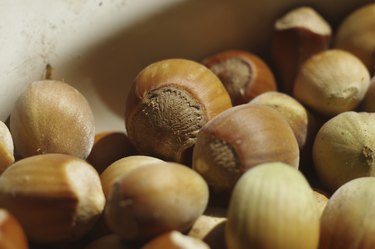
Hazelnut shells, a byproduct of the nut industry, provide a long-lasting and natural mulch option for ornamental beds and areas around trees and shrubs. The nuts are harvested from the hazelnut shrubs (Corylus americana), which grow in U.S Department of Agriculture plant hardiness zones 4 through 9, and the shells are sold as mulch. Although more expensive that other organic mulch options, the shells decompose slowly so they have a longer garden life compared to other mulches. There are a few problems with hazelnut mulches, but most are avoidable if you use the mulch correctly.
Blight Concerns
Video of the Day
Eastern Filbert Blight (Anisogramma anomala) affects hazelnut trees primarily in the Eastern part of the United States and it will cause the eventual death of the tree. Although hazelnut shells do not harbor the disease pathogens, it can come into the garden via twigs mixed in with the shells. Purchasing shells from local sources minimizes the chances of bringing in outside pathogens. If you purchase shells and the source is unknown, inspect the mulch before applying it to make sure there are no twigs mixed in with the branches.
Video of the Day
Wind, Water and Slopes
Lightweight hazelnut shells float in wet areas or blow away where wind is an issue. Rain or irrigation can also wash the nutshells out of sloped beds. Use hazelnut shells in well-drained, level garden beds where water doesn't collect after rain or irrigation. Beds protected from high winds, such as near walls or fences, are also a suitable place for the lightweight mulch. Heavier mulches, such as wood chips, are better suited to areas where wind, slopes or water are a concern.
Soil Nutrition
Unlike other organic mulches, hazelnut shells contain few beneficial nutrients for plants, so they don't fertilize the soil as they decompose. The shells also don't alter the pH of the soil, which can be beneficial if the plants don't require a soil pH adjustment. Hazelnut shells break down slowly, so they don't require frequent reapplication. Fertilizers and other soil amendments must supply the necessary nutrients to the plants to make up for the lack of nutrients supplied by decomposing hazelnut mulch.
Cleaning Up
The relatively round shells don't sweep up well, according to Oregon State University Extension. This primarily poses a problem on hard surfaces, such as when you use the mulch in patio containers or in beds bordering sidewalks or paved patios. Keeping the mulch layer level with surrounding hardscapes in border beds minimizes its spread onto pavement. Keep the soil level in planters 3 inches beneath the rim so any hazelnut shell mulch on top the soil in the container doesn't spill over the sides and onto a patio.